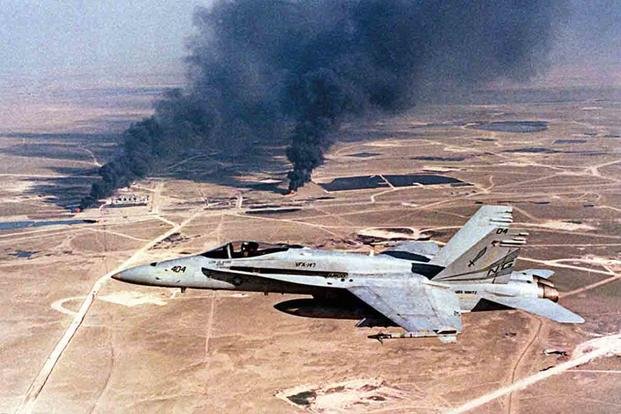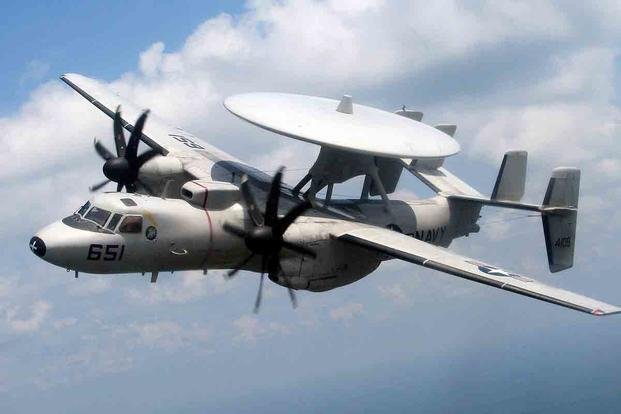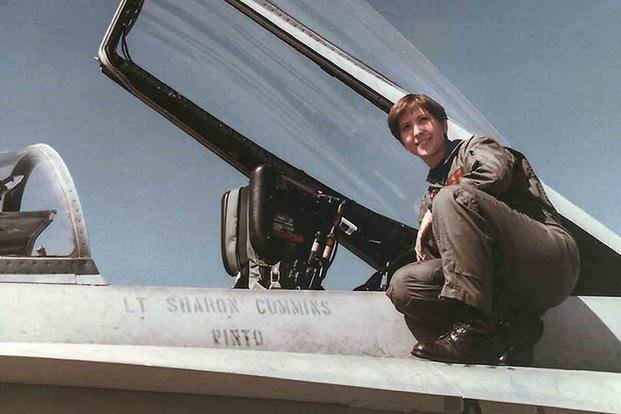It's been 30 years since the first women to fly combat missions for the U.S. military took off from the flight deck of the USS Dwight D. Eisenhower. They started flying in 1994, enforcing no-fly zones in Iraq and Bosnia, but their names were never released. The women told the Smithsonian Institution that there's a reason it took three decades: They wanted to be known for their abilities, not solely because of their gender.
These five women flew different aircraft, but all were stationed aboard the Eisenhower, the Navy's first gender-integrated aircraft carrier. All but Lynne Fowler joined the Navy while the women-in-combat exclusion rule was still in effect. They all just wanted to fly.
Below, they discuss their historic first missions in and around Iraq, but the most intense fighting came later, as the U.S. and NATO intervened in Bosnia and Herzegovina. It was there, during Operation Deny Flight, that a lot of the shooting took place.
Kimberly "Face" Dyson
Lt. Kimberly Dyson became the first woman to fly a combat mission for the United States on Nov. 15, 1994. Both Sharon "Pinto" Deegan (below) and Dyson were scheduled to fly that day, but Deegan's F/A-18 Hornet experienced a mechanical failure and she was grounded for the day. Dyson's Hornet flew on its history-making schedule, however. Her mission was enforcing the no-fly zones over Saddam Hussein's Iraq.
Dyson didn't drop any munitions that day, but Iraq's air defenses were still very much an active threat. In October of that year, Hussein sent two divisions of Iraqi Republican Guard troops to Iraq's border with Kuwait in an attempt to get relief from international sanctions. Lt. Dyson's first sortie from the deck of the Eisenhower was uneventful, save for a woman flying the plane.

Sharon "Pinto" Deegan (née Cummins)
Deegan, also behind the stick of an F/A-18 Hornet, took off from the flight deck the day after Dyson, on Nov. 16, 1994. Along with Joy "Trigger" Dean, their mission for Operation Southern Watch was to identify potential Iraqi targets and engage them if necessary. On this particular day, they were to fly over a suspected surface-to-air (SAM) missile site inside Iraq, fully loaded with air-to-ground munitions and air-to-air missiles.
Joy "Trigger" Dean (née Adams)
Then-Lt. j.g. Joy Dean flew with Lt. Deegan on their mission to fly past the Iraqi SAM site on Nov. 16, 1994. She also flew in the Navy's F/A-18 Hornet from the USS Eisenhower.
"My entire goal was to be a great wingman and to fly perfect combat spread," she told the Smithsonian Institution's Air and Space Quarterly. "I wanted to be ready, have situational awareness, and join up and refuel with the tanker -- get in and get out."
Lisa "KP" Kirkpatrick
Lt. Lisa Kirkpatrick flew a different combat aircraft, one that was safer in some ways, but much less safe in others. As an E-2C Hawkeye airborne early warning and control aircraft, these planes coordinate communications between friendly forces and have a powerful radar to track any aircraft in the battlespace. Their role is battle management for forces in the area and coordination between sea, air and land forces. Simply put, it's a valuable aircraft.
It was so valuable, in fact, the E-2C wasn't allowed to fly over Iraq, lest one get shot down and its information captured. Kirkpatrick's role was to fly along the borders of the country to do her job. The hazards of being a Hawkeye pilot may not seem like much compared to a fighter like the Hornet, but Lt. Kirkpatrick's plane did not have a way to eject from the aircraft.
"If we were hit by a missile, we were never getting out of that airplane," she told the Smithsonian in a May 2023 interview.

Lynne Fowler
Fowler was the pilot of a U.S. Navy Sikorsky SH-3 Sea King helicopter who was also stationed aboard the USS Eisenhower at the time. She was not able to be interviewed for the Smithsonian Institution's winter 2024 article describing the women's historic firsts. Like Kirkpatrick, Dean, Deegan and Dyson, Fowler and her squadron deployed with the Eisenhower to the Persian Gulf to support Operation Southern Watch and later to the Adriatic Sea to support Operation Deny Flight over Bosnia.
Read the full interview and story at the Smithsonian Institution's Air and Space Quarterly.
Want to Learn More About Military Life?
Whether you're thinking of joining the military, looking for post-military careers or keeping up with military life and benefits, Military.com has you covered. Subscribe to Military.com to have military news, updates and resources delivered directly to your inbox.















